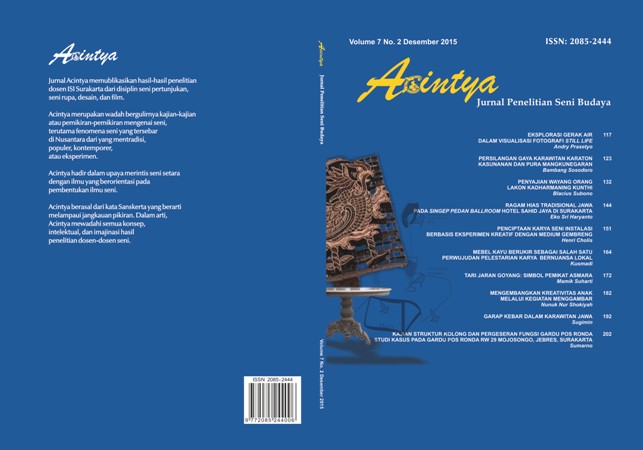PERSILANGAN GAYA KARAWITAN KARATON KASUNANAN DAN PURA MANGKUNEGARAN
DOI:
https://doi.org/10.33153/acy.v7i2.2007Abstract
This research is a field study that examines the karawitan (Javanese music) of Karaton and Mangkunegaran. The selection is based on the material objects of historical reality and the fact of music. It is that they have enough problems as interesting and actual scientific studies to increase the repertoire of Karawitan. Surakarta palace compound and Mangkunegaran are two important pillarssupporting musical identity of Surakarta style. The issue of the Palace and Mangkunegaran Karawitan is an interesting topic to be studied from the various viewpoints. This is because the two kingdoms are at Surakarta style musical territory, but producethe different musical works. Idioms and vocabularies
are working on covering the game Ricikan and gending repertoire.The work of gending between the two are the same but the result of musical taste shows differences. The second issue of the royal musicians is increasingly attractive when the marriage is bond between the Mangkunegaran and Yogyakarta Sultanate.The physical and aesthetic (musical) characteristics are identic between the two. The marriage eventually leds to the musical dance of Yogyakarta style of Mangkunegaran. Although it is said to be identic but on the other hand it is also flowing style of Surakarta. This study aims to reveal the differences and similarities between the music and the dance of Karaton
Mangkunegaran. The discussionsof the two are limited to the Dance Srimpi. To uncover this needs the use of textual and contextual approaches. Textual studies focus on the shape, form, and elements inherent in the study of arts subjects. The musicians sit as a text to be read and interpreted,and the
contextual approach is used to reveal the factors behind the development and the difference between the two. This topic is important to be examined because the study that focuses on the comparison of dance music between the Palace and Mangkunegaran has never been done.
Keywords: Cross culture, karawitan, dance Srimpi, palace, differences and similarities.
Downloads
References
Ahimsa Putra, H.S. Strukturalisme Levi-strauss:
Mitos dan Karya Sastra. Yogyakarta:
Galang Press Yogyakarta, 2001.
Ahimsa Putra, H.S. “Wacana Seni Dalam Antropologi
Budaya: Tekstual, Kontekstual dan PostModernistis†dalam Ketika Orang Jawa
Nyeni. Yogyakarta: Galang Press, 1999.
Darsono. Cokrodiharjo dan Sunarto Cipto
Suwarso: Pengrawit Unggulan Luar
Tembok Kraton. Surakarta: Citra Etnika
Surakarta, 2002.
Koentjaraningrat. Kebudayaan Jawa. Jakarta: Balai
Pustaka, 1984.
Martopangrawit. Pengetahuan Karawitan. Surakarta:
ASKI, 1972.
Mloyowidodo. Gendhing-Gendhing Gaya
Surakarta. Surakarta: ASKI, 1976.
Pradjapangrawit. Serat Sujarah Utawi Riwayating
Gamelan: Wedhapradangga (Serat
Saking Gotek). Surakarta: STSI
Press,1990.
Rustopo. “Keberadaan Karawitan di Karaton
Kasunanan Surakarta Pada Masa
Pemerintahan Paku Buwana X Menurut
Serat Sri Karongron. Laporan Penelitian
Surakarta: Sekolah Tinggi Seni Indonesia
Surakarta, 1994.
Ricklefs, M.C. Sejarah Indonesia Modern. Terj.
Dharmono Hardjowidjono. Yogyakarta:
Gadjah Mada University Press, 1995.
Santoso. “Perkembangan Garap Karawitan Di
Surakartaâ€, Laporan Penelitian, ASKI
Surakarta, 1985/1986.
Sumarsam. Gamelan: Inteaksi Budaya dan
Perkembangan musikal di Jawa.
Yogtakarta: Pusaka Pelajar: 2003.
Supanggah, Rahayu. “Beberapa Pokok Pikiran
Tentang Garapâ€. Makalah disajikan dalam
diskusi mahasiswa dan dosen ASKI
Surakarta, 1983.
________. Bothèkan Karawitan I. Jakarta:
Masyarakat Seni Pertunjukan Indonesia,
S.P, Wahyu. Tari Wireng Gaya Surakarta:
Pengkajian Berdasarkan KonsepKonsep Kridhawayangga dan
Wedhayata. Dalam Jurnal Pengkajian &
Penciptaan Seni. Surakarta: STSI, 2002.
Warsadiningrat. Serat Sesorah Gamelan. Surakarta,
Waridi. Martopangrawit Empu Karawitan Gaya
Surakarta. Yogyakarta: Mahavira, 2001.
________.Karawitan Jawa Masa Pemerintahan
PB X: Perspektif Historis dan Teoritis.
Surakarta: ISI Press, 2006.
Zainudin Fananie. Pandangan Dunia KGPAA
Hamangkoenagoro I dalam Babad
Tutur: Sebuah Restrukturasi Budaya.
Surakarta: Muhammadiyah University
Press, 1994.
Downloads
Published
How to Cite
Issue
Section
License
Copyright (c) 2017 Bambang Sosodoro

This work is licensed under a Creative Commons Attribution 4.0 International License.
Author continues to retain the copyright if the article is published in this journal. The publisher will only need publishing rights




